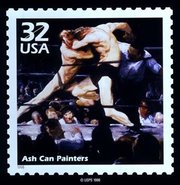Visual arts of the United States
|
|
| U.S. arts |
| Architecture |
| Comics |
| Cuisine |
| Dance |
| Folklore |
| Literature |
| Movies |
| Music |
| Painting |
| Poetry |
| Sculpture |
| Television |
| Theater |
| Visual arts |
America's first well-known school of painting—the Hudson River School—appeared in 1820. As with music and literature, this development was delayed until artists perceived that the New World offered subjects unique to itself; in this case the westward expansion of settlement brought the transcendent beauty of frontier landscapes to painters' attention.
The Hudson River painters' directness and simplicity of vision influenced such later artists as Winslow Homer (1836-1910), who depicted rural America—the sea, the mountains, and the people who lived near them. Middle-class city life found its painter in Thomas Eakins (1844-1916), an uncompromising realist whose unflinching honesty undercut the genteel preference for romantic sentimentalism.
Controversy soon became a way of life for American artists. In fact, much of American painting and sculpture since 1900 has been a series of revolts against tradition. "To hell with the artistic values," announced Robert Henri (1865-1929). He was the leader of what critics called the "ash-can" school of painting, after the group's portrayals of the squalid aspects of city life. Soon the ash-can artists gave way to modernists arriving from Europe—the cubists and abstract painters promoted by the photographer Alfred Stieglitz (1864-1946) at his Gallery 291 in New York City.
In the years after World War II, a group of young New York artists formed the first native American movement to exert major influence on foreign artists: abstract expressionism. Among the movement's leaders were Jackson Pollock (1912-1956), Willem de Kooning (1904-1997), and Mark Rothko (1903-1970). The abstract expressionists abandoned formal composition and representation of real objects to concentrate on instinctual arrangements of space and color and to demonstrate the effects of the physical action of painting on the canvas.
Members of the next artistic generation favored a different form of abstraction: works of mixed media. Among them were Robert Rauschenberg (1925- ) and Jasper Johns (1930- ), who used photos, newsprint, and discarded objects in their compositions. Pop artists, such as Andy Warhol (1930-1987), Larry Rivers (1923-2002), and Roy Lichtenstein (1923- ), reproduced, with satiric care, everyday objects and images of American popular culture—Coca-Cola bottles, soup cans, comic strips.
Today artists in America tend not to restrict themselves to schools, styles, or a single medium. A work of art might be a performance on stage or a hand-written manifesto; it might be a massive design cut into a Western desert or a severe arrangement of marble panels inscribed with the names of American soldiers who died in Vietnam. Perhaps the most influential 20th-century American contribution to world art has been a mocking playfulness, a sense that a central purpose of a new work is to join the ongoing debate over the definition of art itself.
Notable figures
American artists of note include Thomas Hart Benton, Andy Warhol, Georgia O'Keeffe, Mary Cassatt, Frederic Remington, N.C. Wyeth, Andrew Wyeth, Winslow Homer, Man Ray, Dorothea Lange, Robert Capa, Ansel Adams, Augustus Saint-Gaudens, John James Audubon, Gilbert Stuart, Alexander Calder, Dale Chihuly, Louis Comfort Tiffany, Norman Rockwell, Dr. Seuss, and Jackson Pollock. Major American architects include Frank Lloyd Wright, Albert Kahn, Buckminster Fuller, Louis Sullivan and Frank Gehry.

